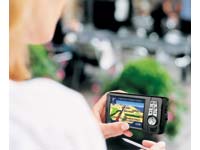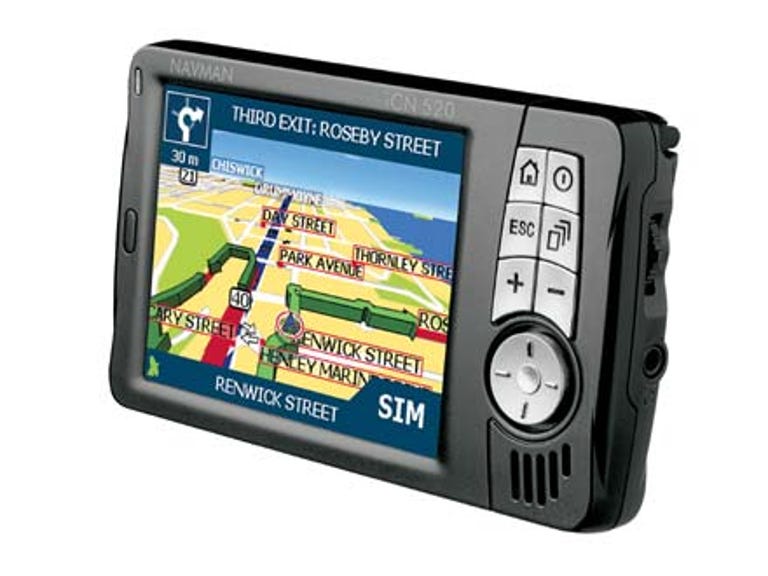 Why You Can Trust CNET
Why You Can Trust CNET Navman iCN 520 review: Navman iCN 520
The Navman iCN 520 scores higly for ease of use and the power of its features, but falls down on getting an initial GPS fix on your location.
Design
While gadgets like PDAs are rapidly
adopting GPS technologies, it's interesting to see that the pure
GPS market is also borrowing from the PDA world, at least in
terms of design. When switched off, there's nothing that the
Navman iCN 520 resembles more than a PDA. Styled in black plastic
with a directional pad and selection buttons on what first
appears to be the bottom of the unit -- but is in fact the right
hand front side once the unit's powered up. The right hand
physical side houses a jog dial for volume settings, a standard
headphone jack and the unit's stylus, while an SD card slot on
the left hand side is where map data is loaded in. Our test unit
came with maps of Australia, although international maps are also
available. The rear of the unit houses the unit's flat
rectangular antenna
The Good
The Bad
The Bottom Line
The display on the iCN 520 is a 3.5" TFT 65K display with a maximum resolution of 320x240, which is plenty of detail for the maps provided with the unit. The kit also includes a housing for physically placing the Navman in your car, a remote control, in-car charger, a case and a power pack for direct mains charging.
Features
The iCN 520 features an Intel PXA-255
300MHz processor and 32MB of dedicated application memory,
although this isn't user-accessible in any case. The software
offering, as with most in-car GPS devices, is built around
navigating to predetermined destinations, accessible at any point
by hitting the home button. From there you can search for
destinations based around city names, streets or points of
interest; these can then be used immediately or saved as
favourite driving destinations. Unlike the
TomTom Go500, there's no facility for automatically searching
for alternate routes, although the choices open to you in terms
of how often you use toll roads, unsealed roads or ferries do
give you a fair amount of customisation. The software will also
track average car speed and can be used as a primitive speed
limiter, sounding an alarm when you exceed a predetermined
limit.
Map displays can be tilted for longer distance viewing, as well as zoomed in and out to display more or less of your planned trip. One nice feature of the map display is that commonly needed data -- such as travelling speed, distance to destination and next relevant turning destination -- can be quickly accessed either via onscreen virtual buttons or the buttons on the right hand side of the display. Points of interest can be toggled to display depending on your preferences and are quite extensive, including petrol stations, train stations, medical centres and even parkland. Given the amount of data that the Navman can display, it's also nice to see that it warns drivers against using it in a solo fashion, and will ask you if you're entering data if you're a passenger or not. As with other in-car GPS devices, the iCN520 offers spoken word directions in multiple languages, with the volume being controlled via the jog dial on the side.
Performance
We tested the iCN 520 with a mixture
of short-range suburban Sydney driving and a longer range drive
from Sydney to the Hunter Valley. While we were impressed with
the map data and ease of use in searching for destinations with
the unit, once we were set up in a car we hit a more fundamental
problem. Most of the time when powering the unit up, it took far
too long to actually procure a GPS fix; in a good situation this
only took around 30 seconds, but on several instances it was
upwards of three or more minutes. Obviously, if you're working in
a situation where your car is garaged, or even under a carport,
this isn't anywhere near ideal. Once we did have a GPS fix,
however, the iCN 520 was exceptionally good at maintaining that
satellite link and quickly re-orienting itself if signal was
lost.
Driving directions given by the unit were generally good, although we did manage to start an in-car argument about whether "bearing" left and "turning" left were the same thing -- and the iCN 520 seems to use both terms interchangeably. It's also remarkably hard not to start emoting with (and intermittently arguing with) the voice of the iCN 520, although that's arguably a better solution than giving in to actual road rage. We also noticed that there was some map data in the more obscure parts of the Hunter Valley that had slightly incorrect road names. Battery life of the unit was good, lasting for around four hours without any external charging; an in-car cigarette-lighter style charger is included, so longer trips are certainly possible.

In-car GPS is perhaps the most obvious use of a GPS in the Australian context, but the iCN520 scores additional points from us as it is actually light and portable enough to be used as a handheld GPS if you're interested in such things as geocaching; it's not as truly portable as a smaller GPS would be, but it will slip easily into a pocket if required.


